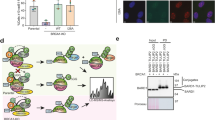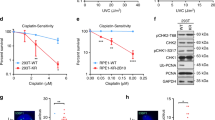Abstract
The RAD6 pathway is central to post-replicative DNA repair in eukaryotic cells; however, the machinery and its regulation remain poorly understood. Two principal elements of this pathway are the ubiquitin-conjugating enzymes RAD6 and the MMS2–UBC13 heterodimer, which are recruited to chromatin by the RING-finger proteins RAD18 and RAD5, respectively. Here we show that UBC9, a small ubiquitin-related modifier (SUMO)-conjugating enzyme, is also affiliated with this pathway and that proliferating cell nuclear antigen (PCNA)—a DNA-polymerase sliding clamp involved in DNA synthesis and repair—is a substrate. PCNA is mono-ubiquitinated through RAD6 and RAD18, modified by lysine-63-linked multi-ubiquitination—which additionally requires MMS2, UBC13 and RAD5—and is conjugated to SUMO by UBC9. All three modifications affect the same lysine residue of PCNA, suggesting that they label PCNA for alternative functions. We demonstrate that these modifications differentially affect resistance to DNA damage, and that damage-induced PCNA ubiquitination is elementary for DNA repair and occurs at the same conserved residue in yeast and humans.
This is a preview of subscription content, access via your institution
Access options
Subscribe to this journal
Receive 51 print issues and online access
$199.00 per year
only $3.90 per issue
Buy this article
- Purchase on SpringerLink
- Instant access to full article PDF
Prices may be subject to local taxes which are calculated during checkout





Similar content being viewed by others
References
Prakash, S., Sung, P. & Prakash, L. DNA repair genes and proteins of Saccharomyces cerevisiae. Annu. Rev. Genet. 27, 33–70 (1993)
Friedberg, E. C., Walker, G. C. & Siede, W. DNA Repair and Mutagenesis (American Society for Microbiology, Washington, 1995)
Hoeijmakers, J. H. Genome maintenance mechanisms for preventing cancer. Nature 411, 366–374 (2001)
Ulrich, H. D. Degradation or maintenance: actions of the ubiquitin system on eukaryotic chromatin. Eukaryotic Cell 1, 1–10 (2002)
Jentsch, S., McGrath, J. P. & Varshavsky, A. The yeast DNA repair gene RAD6 encodes a ubiquitin-conjugating enzyme. Nature 329, 131–134 (1987)
Broomfield, S., Chow, B. L. & Xiao, W. MMS2, encoding a ubiquitin-conjugating-enzyme-like protein, is a member of the yeast error-free postreplication repair pathway. Proc. Natl Acad. Sci. USA 95, 5678–5683 (1998)
Hofmann, R. M. & Pickart, C. M. Noncanonical MMS2-encoded ubiquitin-conjugating enzyme functions in assembly of novel polyubiquitin chains for DNA repair. Cell 96, 645–653 (1999)
Xiao, W. et al. Genetic interactions between error-prone and error-free postreplication repair pathways in Saccharomyces cerevisiae. Mutat. Res. 435, 1–11 (1999)
Ulrich, H. D. & Jentsch, S. Two RING finger proteins mediate cooperation between ubiquitin-conjugating enzymes in DNA repair. EMBO J. 19, 3388–3397 (2000)
Moraes, T. F. et al. Crystal structure of the human ubiquitin conjugating enzyme complex, hMms2-hUbc13. Nature Struct. Biol. 8, 669–673 (2001)
VanDemark, A. P., Hofmann, R. M., Tsui, C., Pickart, C. M. & Wolberger, C. Molecular insights into polyubiquitin chain assembly: crystal structure of the Mms2/Ubc13 heterodimer. Cell 105, 711–720 (2001)
Bailly, V., Lamb, J., Sung, P., Prakash, S. & Prakash, L. Specific complex formation between yeast RAD6 and RAD18 proteins: a potential mechanism for targeting RAD6 ubiquitin-conjugating activity to DNA damage sites. Genes Dev. 8, 811–820 (1994)
Pickart, C. M. Ubiquitin in chains. Trends Biochem. Sci. 25, 544–548 (2000)
Melchior, F. SUMO-nonclassical ubiquitin. Annu. Rev. Cell Dev. Biol. 16, 591–626 (2000)
Müller, S., Hoege, C., Pyrowolakis, G. & Jentsch, S. SUMO, ubiquitin's mysterious cousin. Nature Rev. Mol. Cell Biol. 2, 202–210 (2001)
Hochstrasser, M. New structural clues to substrate specificity in the “ubiquitin system”. Mol. Cell 9, 453–454 (2002)
Tsurimoto, T. PCNA binding proteins. Frontiers Biosci. 4, 849–858 (1999)
Warbrick, E. The puzzle of PCNA's many partners. BioEssays 22, 997–1006 (2000)
Bauer, G. A. & Burgers, P. M. Molecular cloning, structure and expression of the yeast proliferating cell nuclear antigen gene. Nucleic Acids Res. 18, 261–265 (1990)
Johnson, E. S. & Blobel, G. Cell cycle-regulated attachment of the ubiquitin-related protein SUMO to the yeast septins. J. Cell Biol. 147, 981–994 (1999)
Torres-Ramos, C. A., Yoder, B. L., Burgers, P. M., Prakash, S. & Prakash, L. Requirement of proliferating cell nuclear antigen in RAD6-dependent postreplicational DNA repair. Proc. Natl Acad. Sci. USA 93, 9676–9681 (1996)
Spence, J., Sadis, S., Haas, A. L. & Finley, D. A ubiquitin mutant with specific defects in DNA repair and multiubiquitination. Mol. Cell. Biol. 15, 1265–1273 (1995)
Ayyagari, R., Impellizzeri, K. J., Yoder, B. L., Gary, S. L. & Burgers, P. M. A mutational analysis of the yeast proliferating cell nuclear antigen indicates distinct roles in DNA replication and DNA repair. Mol. Cell. Biol. 15, 4420–4429 (1995)
Joazeiro, C. A. & Weissman, A. M. RING finger proteins: mediators of ubiquitin ligase activity. Cell 102, 549–552 (2000)
Bernier-Villamor, V., Sampson, D. A., Matunis, M. J. & Lima, C. D. Structural basis for E2-mediated SUMO conjugation revealed by a complex between ubiquitin-conjugating enzyme Ubc9 and RanGAP1. Cell 108, 345–356 (2002)
Prakash, L. The RAD6 gene and protein of Saccharomyces cerevisiae. Ann. NY Acad. Sci. 726, 267–273 (1994)
Johnson, R. E. et al. Saccharomyces cerevisiae RAD5-encoded DNA repair protein contains DNA helicase and zinc-binding sequence motifs and affects the stability of simple repetitive sequences in the genome. Mol. Cell. Biol. 12, 3807–3818 (1992)
Lawrence, C. W. & Christensen, R. B. Metabolic suppressors of trimethoprim and ultraviolet light sensitivities of Saccharomyces cerevisiae rad6 mutants. J. Bacteriol. 139, 866–887 (1979)
Schiestl, R. H., Prakash, S. & Prakash, L. The SRS2 suppressor of rad6 mutations of Saccharomyces cerevisiae acts by channeling DNA lesions into the RAD52 DNA repair pathway. Genetics 124, 817–831 (1990)
Ulrich, H. D. The srs2 suppressor of UV sensitivity acts specifically on the RAD5- and MMS2-dependent branch of the RAD6 pathway. Nucleic Acids Res. 29, 3487–3494 (2001)
Broomfield, S. & Xiao, W. Suppression of genetic defects within the RAD6 pathway by srs2 is specific for error-free post-replication repair but not for damage-induced mutagenesis. Nucleic Acids Res. 30, 732–739 (2002)
Zhang, Z., Shibahara, K. & Stillman, B. PCNA connects DNA replication to epigenetic inheritance in yeast. Nature 408, 221–225 (2000)
Krishna, T. S. et al. Crystallization of proliferating cell nuclear antigen (PCNA) from Saccharomyces cerevisiae. J. Mol. Biol. 241, 265–268 (1994)
Amin, N. S. & Holm, C. In vivo analysis reveals that the interdomain region of the yeast proliferating cell nuclear antigen is important for DNA replication and DNA repair. Genetics 144, 479–493 (1996)
Eissenberg, J. C., Ayyagari, R., Gomes, X. V. & Burgers, P. M. Mutations in yeast proliferating cell nuclear antigen define distinct sites for interaction with DNA polymerase δ and DNA polymerase ɛ. Mol. Cell. Biol. 17, 6367–6378 (1997)
Johnson, E. S. & Gupta, A. A. An E3-like factor that promotes SUMO conjugation to the yeast septins. Cell 106, 735–744 (2001)
Cejka, P., Vondrejs, V. & Storchova, Z. Dissection of the functions of the Saccharomyces cerevisiae RAD6 postreplicative repair group in mutagenesis and UV sensitivity. Genetics 159, 953–963 (2001)
Xiao, W., Chow, B. L., Broomfield, S. & Hanna, M. The Saccharomyces cerevisiae RAD6 group is composed of an error-prone and two error-free postreplication repair pathways. Genetics 155, 1633–1641 (2000)
Torres-Ramos, C. A., Prakash, S. & Prakash, L. Requirement of RAD5 and MMS2 for postreplication repair of UV-damaged DNA in Saccharomyces cerevisiae. Mol. Cell. Biol. 22, 2419–2426 (2002)
Deng, L. et al. Activation of the IκB kinase complex by TRAF6 requires a dimeric ubiquitin-conjugating enzyme complex and a unique polyubiquitin chain. Cell 103, 351–361 (2000)
Wang, C. et al. TAK1 is a ubiquitin-dependent kinase of MKK and IKK. Nature 412, 346–351 (2001)
Spence, J. et al. Cell cycle-regulated modification of the ribosome by a variant multiubiquitin chain. Cell 102, 67–76 (2000)
Galan, J. M. & Haguenauer-Tsapis, R. Ubiquitin lys63 is involved in ubiquitination of a yeast plasma membrane protein. EMBO J. 16, 5847–5854 (1997)
Brusky, J., Zhu, Y. & Xiao, W. UBC13, a DNA-damage-inducible gene, is a member of the error-free postreplication repair pathway in Saccharomyces cerevisiae. Curr. Genet. 37, 168–174 (2000)
Tateishi, S., Sakuraba, Y., Masuyama, S., Inoue, H. & Yamaizumi, M. Dysfunction of human Rad18 results in defective postreplication repair and hypersensitivity to multiple mutagens. Proc. Natl Acad. Sci. USA 97, 7927–7932 (2000)
Li, Z., Xiao, W., McCormick, J. J. & Maher, V. M. Identification of a protein essential for a major pathway used by human cells to avoid UV-induced DNA damage. Proc. Natl Acad. Sci. USA 99, 4459–4464 (2002)
Desterro, J. M., Rodriguez, M. S. & Hay, R. T. SUMO-1 modification of IκBα inhibits NF-κB activation. Mol. Cell 2, 233–239 (1998)
Seufert, W., Futcher, B. & Jentsch, S. Role of a ubiquitin-conjugating enzyme in degradation of S- and M-phase cyclins. Nature 373, 78–81 (1995)
Knop, M. et al. Epitope tagging of yeast genes using a PCR-based strategy: more tags and improved practical routines. Yeast 15, 963–972 (1999)
Li, S. J. & Hochstrasser, M. A new protease required for cell-cycle progression in yeast. Nature 398, 246–251 (1999)
Treier, M., Staszewski, L. M. & Bohmann, D. Ubiquitin-dependent c-Jun degradation in vivo is mediated by the δ domain. Cell 78, 787–798 (1994)
Müller, S. et al. c-Jun and p53 activity is modulated by SUMO-1 modification. J. Biol. Chem. 275, 13321–13329 (2000)
Acknowledgements
We thank U. Cramer for technical assistance and S. Müller and M. Knop for experimental advice and discussions. We also thank P. Burgers, D. Finley, M. Hochstrasser, M. Knop, S. Müller and B. Stillman for plasmids and strains. S.J. is supported by the Max Planck Society, Deutsche Forschungsgemeinschaft and Fonds der chemischen Industrie.
Author information
Authors and Affiliations
Corresponding author
Ethics declarations
Competing interests
The authors declare that they have no competing financial interests.
Rights and permissions
About this article
Cite this article
Hoege, C., Pfander, B., Moldovan, GL. et al. RAD6-dependent DNA repair is linked to modification of PCNA by ubiquitin and SUMO. Nature 419, 135–141 (2002). https://doi.org/10.1038/nature00991
Received:
Accepted:
Issue Date:
DOI: https://doi.org/10.1038/nature00991



